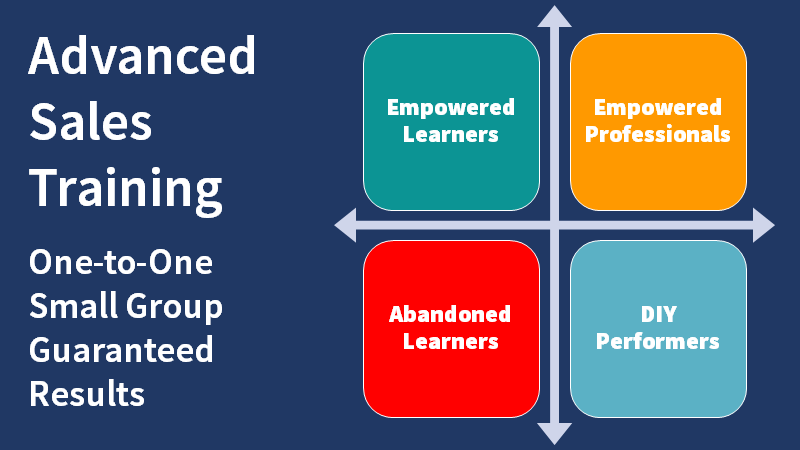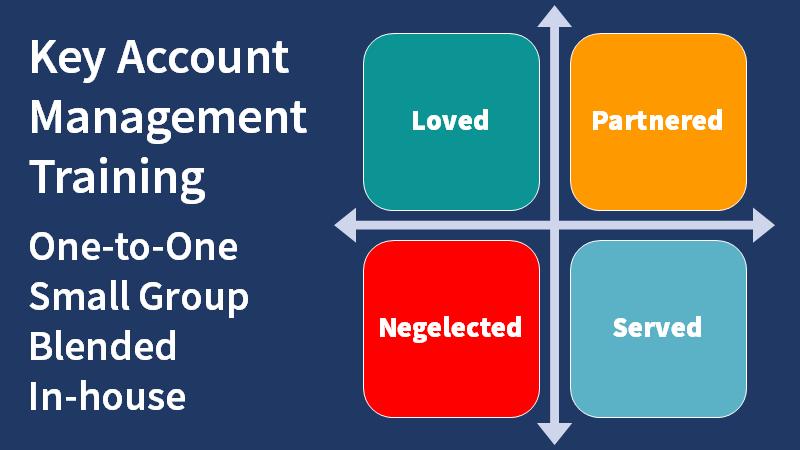Increase new logo business with a sales prospecting training course.

Integrate proven techniques with the new methods and only reach out to people with an immediate need for what you are selling. This sales prospecting training course leverages the best of the old and the reach of the new to accelerate new customer acquisition.
What sets a sales prospecting training course apart from others?
- Comparing current methods with commonly held best practices. See a list at the bottom of this page.
- Being able to explore the content in advance and then using the training time for preparation and practical real-world exercises.
- The opportunity to improve processes and methods.
- Developing actions and reminders for applying learning in the workplace.
- The option for private sessions with the course author.
- Delivery by the course author.
- Guaranteed results.
The twenty-first century has brought huge changes to selling yet many old principles remain the same. Getting the attention of executives and initiating a meaningful business dialogue remains the most challenging sales task.
The ability to make new connections when the time is right is the most sought-after selling skill. Nothing else presents such awkward obstacles, yet there are tried and tested methods for getting the attention of decision-makers, engaging them in a business conversation, and setting up sales calls.
Course Approach
Action is the key to learning progress. All of our business development courses are organised around this principle. Participants are invited to identify their current process, the obstacles that impede success, and the relative importance of overcoming each obstacle. Then the course content provides frameworks for developing new methods and practices that embed learning in workplace practices.
Approach Benefits
- Maximum buy-in from the participants.
- Practical actionable implementation framework for your environment.
- Allows the trainer to seed ideas, use cases, and tools without being prescriptive.
- Provides complete programme flexibility without compromising objectives.
- Results in behavioural change, improved business predictability, and increased sales results.
Take this learning programme to acquire today's best practices, methods, and habits and gain the most saleable skill in the commercial world.
Sales Prospecting Training Course Objectives

- Find prospects who want to buy now.
- Identify the true decision makers.
- Understand senior-level decision-making.
- Learn the seven approach tactics.
- Prepare better messaging.
- Develop better questions.
- Explore sales behaviour from the customer's perspective.
- Do and say the right things.
Who Should Attend:
Business development salespeople tasked with winning new business; account managers who need more access to senior managers and directors, and Managers who want to develop their team's sales prospecting skills.
Additional Programme Benefits
- Flexible multi-session 'learning by doing' structured training course.
- Workplace assignments develop new habits and practices.
- Tools, templates, frameworks, and examples save time and aid learning.
- Common language improves communication and teamwork.
- Promotes adoption of best practice habits and methods.
- Increases sales productivity, consistency, and results.
- Improves job satisfaction and motivation.
- Reduces staff turnover.
Sales Prospecting Training Course Delivery Options
- One to One - via five 2-hour or ten 1-hour virtual meetings with the course author.
- £995 Learn more.
- One to One on a per-session basis.
- £150 Learn more.
- Via Online Group Training - Delivered through five 2-hour or ten 1-hour virtual classroom sessions led by the course author.
- £3995 for up to fifteen people.
- Group Training on selected content.
- £450 per 1-hour session for up to fifteen people. Learn more.
- Fees exclude applicable VAT.
- Traditional Classroom - Delivery over one or more days at a conference venue or the customer's offices. Contact us for fees.
What are B2B sales prospecting best practices?
B2B sales prospecting requires a strategic approach to identify, engage, and qualify potential clients effectively. Here are some best practices to enhance your prospecting efforts:
1. Define Your Ideal Customer Profile (ICP)
Clearly identify the characteristics of businesses most likely to benefit from your products or services. This helps to focus your efforts on the right prospects and tailor your approach.
2. Leverage LinkedIn for Research
Use LinkedIn to research key decision-makers and understand their professional background, challenges, and interests. LinkedIn Sales Navigator is particularly useful for advanced filtering and targeting.
3. Utilise Personalisation in Outreach
Customise your outreach messages based on your research. Mention specific challenges the prospect's business may be facing and how your solution can address them. Personalisation demonstrates that you’ve invested time to understand their needs.
4. Focus on Multi-Channel Outreach
Use a combination of email, LinkedIn, phone calls, and other channels to engage with prospects. Each prospect might respond differently depending on the medium, so varying your approach can yield better results.
5. Add Value Before Selling
Provide value early in your interactions by sharing relevant insights, reports, or content that can help the prospect. It establishes credibility and positions you as a knowledgeable partner rather than just a salesperson.
6. Use Data to Drive Decisions
Track and analyse the performance of your outreach campaigns. Metrics like response rates, open rates, and conversion rates can indicate what is working and where improvements are needed.
7. Develop a Follow-Up Strategy
Persistence is key in B2B sales. Develop a structured follow-up plan that ensures you stay on a prospect's radar without being overbearing. A mix of email nudges, LinkedIn messages, and calls over a few weeks can improve your chances of connecting.
8. Time Your Outreach Effectively
Timing can impact the success of your outreach. Research indicates that certain times of the day or week are better for contacting potential clients. Test and adjust your timing to maximise response rates.
9. Qualify Early and Often
Quickly assess whether a prospect fits your ICP and has genuine intent or need for your offering. Qualifying prospects early ensures you invest your time in leads that have higher conversion potential.
10. Refine Your Pitch Continuously
Use feedback from your outreach to refine your pitch. Tailor your value proposition based on the feedback you receive, and be prepared to adjust your messaging to suit different industries or business sizes.
11. Practice Active Listening
When communicating with prospects, listen actively to understand their pain points thoroughly. Prospects value feeling heard and understood, and it allows you to position your solution more effectively.
12. Incorporate Social Proof
Mention successful case studies, testimonials, or known clients in your communications to build credibility and trust. Prospects often feel reassured when they see that similar companies have benefited from your solution.
13. Automate Where Possible, but Maintain a Human Touch
Use automation tools to streamline repetitive tasks like email sequences, but make sure key messages and interactions maintain a human element. The personal touch can make a significant difference in B2B relationships.
These best practices can help build a robust B2B sales prospecting strategy that effectively engages potential clients and moves them through the sales funnel.
Large Numbers
Licensing and train-the-trainer options enable self-delivery. To find out more, call or use the links below. Associate and Affiliate representation is welcomed. To promote or deliver this course, get in touch directly.
Want Something Different? Please Ask:
If you are looking for sales prospecting training, need to find a business development managers course, or start more sales conversations, we can help. Telephone +44 (0)1392 851500. Alternatively, use the contact form here or email custserv@salessense.co.uk.






















